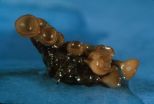(Press-News.org) Using data from more than 270,000 hospital stroke admissions, scientists have identified how to predict which patients are at greatest risk of dying in the hospital after stroke. Before their study, well validated models to predict in-hospital death risk after stroke were lacking, the researchers reported in Circulation: Journal of the American Heart Association.
"A mortality risk assessment tool for hospitalized stroke patients is important to clinicians, hospitals and patients," said Eric E. Smith, M.D., M.P.H., lead author of the study and assistant professor of neurology at the Hotchkiss Brain Institute at the University of Calgary in Alberta, Canada.
"Doctors can use this information to find out who is at highest risk and try to help prevent them from dying," he said. "Patients and families can benefit from this information by understanding their prognoses better. Hospitals can use our mortality risk score to calculate the mortality rate that they would expect to see, based on the characteristics of their own patients, and compare that to their actual observed mortality."
Smith and colleagues used the American Heart Association/American Stroke Association Get With The Guidelines®–Stroke registry to analyze hospital stroke admissions from 2001-07.
"This enormous database offers an unparalleled opportunity to learn more about stroke and how stroke care is delivered," Smith said.
They divided patients by those who died and those who survived, analyzed the characteristics of each group and then identified the characteristics that predicted in-hospital death post-stroke.
"We used these results to make a risk score," Smith said. "One of our findings was that a measure of stroke severity, called the NIH [National Institutes of Health] Stroke Scale, was a very strong predictor of mortality risk. Unfortunately, this scale is only recorded about 40 percent of the time; we separately derived a risk score in patients whose NIH Stroke Scale score was recorded. This results in two risk scores that a hospital may use — one for patients where the NIH score was recorded and one where it was not."
The researchers found that 5.5 percent of patients admitted for stroke died in the hospital. Being older, arriving by ambulance and having atrial fibrillation (irregular heartbeat) were individually associated with the largest increased risk of dying.
Less impactful independent predictors of death risk were previous stroke history, known carotid stenosis (artery narrowing), high blood pressure, high cholesterol and current smoking.
Using the risk score that didn't include the NIH stroke scale, the researchers predicted that the risk of death was 0.7 percent in the lowest category of risk, while the risk of death was 16.2 percent in the highest category of risk. With the NIH Stroke Scale score, they predicted that risk of death in the lowest category was 0.4 percent, versus 26.8 percent in the highest risk category.
"We showed that the risk score that included the NIH Stroke Scale score made more accurate predictions," Smith said. "Clearly, stroke severity is the most important predictor of outcome — even more important than the person's age and medical history."
These findings should encourage more care providers to assess their stroke patients using the NIH Stroke Scale, said Ralph Sacco, M.D., president of the American Heart Association. Information and training materials for the NIH Stroke Scale are available for free, including on the American Heart Association website at http://learn.heart.org/ihtml/application/student/interface.heart2/nihss.html.
"In addition to helping in the decision-making process of each stroke patient's care, this mortality model helps in the big picture of Get With The Guideline data collection and benchmarking by adjusting for differences in patient mix across hospitals," Sacco said.
One limitation of the study is that researchers only examined data on patients with ischemic stroke, caused by a blockage of blood flow to the brain, which accounts for about 85 percent of all strokes. They don't know whether the predictions are valid for patients with other types of stroke.
###
Co-authors are: Nandavar Shobha, D.N.B., D.M.; David Dai, Ph.D., DaiWai M. Olson, Ph.D., R.N.; Mathew J. Reeves, Ph.D.; Jeffrey L. Saver, M.D.; Adrian F. Hernandez, M.D.; Eric D. Peterson, M.D., M.P.H.; Gregg C. Fonarow, M.D.; and Lee H. Schwamm, M.D.
Author disclosures and funding sources are on the manuscript.
Statements and conclusions of study authors published in American Heart Association scientific journals are solely those of the study authors and do not necessarily reflect the association's policy or position. The association makes no representation or guarantee as to their accuracy or reliability. The association receives funding primarily from individuals; foundations and corporations (including pharmaceutical, device manufacturers and other companies) also make donations and fund specific association programs and events. The association has strict policies to prevent these relationships from influencing the science content. Revenues from pharmaceutical and device corporations are available at www.americanheart.org/corporatefunding.
Editor's note: Stay up to date on the latest news from American Heart Association scientific meetings, including Scientific Sessions 2010, by following us at www.twitter.com/heartnews. We will be tweeting from the conference using hashtag #AHA10News.
Additional Resources/Information:
Downloadable stock footage, animation, and our image gallery are located at www.heart.org/news under Multimedia.
For more information on Get With The Guidelines®, visit www.heart.org/quality.
Get With The Guidelines®–Stroke (GWTG-Stroke) is provided by the American Heart Association/American Stroke Association. The program is currently supported in part by a charitable contribution from Bristol-Myers Squib/Sanofi Pharmaceutical Partnership and the American Heart Association Pharmaceutical Roundtable. GWTG-Stroke has been funded in the past through support from Boeringher-Ingelheim and Merck.
END
VIDEO:
In a few tenths of a second, Sclerotinia expels hundreds of thousands of spores in a plume that can rise 20 cm, much higher than any single spore by itself....
Click here for more information.
Long before geese started flying in chevron formation or cyclists learned the value of drafting, fungi discovered an aerodynamic way to reduce drag on their spores so as to spread them as high and as far as possible.
One fungus, the destructive Sclerotinia sclerotiorum, ...
In a paper published this week in the Proceedings of the National Academy of Sciences, Cary Institute aquatic ecologist Dr. Emma Rosi-Marshall and colleagues report that streams throughout the Midwestern Corn Belt are receiving insecticidal proteins that originate from adjacent genetically modified crops. The protein enters streams through runoff and when corn leaves, stalks, and plant parts are washed into stream channels.
Genetically-modified plants are a mainstay of large-scale agriculture in the American Midwest, where corn is a dominant crop. In 2009, more than ...
Burness Communications
Godwin Atser
g.atser@cgiar.org
234-803-443-0027
CGIAR
Scientists arrive in Senegal to give African hunger a black eye
At the World Cowpea Research Conference, crop experts embrace one of agriculture's oldest legumes -- prized for protein and resilience to hot, dry climates -- as food for people, livestock and astronauts
This release is available in French.
DAKAR, SENEGAL (27 September 2010)—A long neglected crop with the potential to halt hunger for millions in Africa, sustain the livestock revolution underway in developing countries, ...
Researchers in the Midwest are developing microelectronic circuitry to guide the growth of axons in a brain damaged by an exploding bomb, car crash or stroke. The goal is to rewire the brain connectivity and bypass the region damaged by trauma, in order to restore normal behavior and movement.
Pedram Mohseni, a professor of electrical engineering and computer science at Case Western Reserve University, and Randolph J. Nudo, a professor of molecular and integrative physiology at Kansas University Medical Center, believe repeated communications between distant neurons in ...
Baby boomers appear to be driving a dramatic rise in suicide rates among middle-aged people, a new study finds.
The suicide rate for middle-aged people – a group considered relatively protected from suicide and with historically stable suicide rates – took an upward jump between 1999 and 2005, according to research by sociologists Ellen Idler of Emory University and Julie Phillips of Rutgers University.
Their study has been published in the September/October issue of the journal Public Health Reports.
"The findings are disturbing, because they're a reversal of a long-standing ...
A report presented today by Health and Consumer Policy Commissioner John Dalli to the Agriculture Council concludes that specific measures relating to storing and the application of isolation distances can help limit or avoid the co-mingling of genetically modified (GM) maize with conventional and organic maize. In particular, the Best Practice Document, prepared by the European Coexistence Bureau (ECoB) and published by the European Commission's Joint Research Centre (JRC), notes that storing seeds adequately and applying spatial isolation are the best ways to limit or ...
TORONTO, Sept. 27, 2010 − Homeless young people are victims of crime at rates that society would consider unacceptable for any other group, according to a new report by researchers at York University and the University of Guelph.
The report, Surviving Crime and Violence: Street Youth and Victimization in Toronto, highlights the degree to which it is street youth themselves − often perceived as delinquent and dangerous − who are vulnerable to crime and violence.
"The very people we are taught to fear are the ones who are most at risk," said Professor ...
Researchers have long held that there are steps that can be taken to make brainstorming sessions more productive. New research from North Carolina State University finds that these recommendations actually do contribute to success when applied in real-world business environments.
"Previous research has laid out best practices that are conducive to brainstorming, or group decision making, and we wanted to see whether using those practices makes a difference in the real world," says Dr. Joe Brazel, associate professor of accounting at NC State and co-author of a paper describing ...
The appearance of a spot of light on the retina causes sudden activation of millions of neurons in the brain within tenths of milliseconds. At the first cortical processing stage, the primary visual cortex, each neuron thereby receives thousands of inputs from both close neighbors and further distant neurons, and also sends-out an equal amount of output to others.
During the recent decades, individual characteristics of these widespread network connections and the specific transfer characteristics of single neurons have been widely derived. However, a coherent population ...
Diclofenac, an anti-inflammatory agent, has been deployed successfully in human medicine for decades. In most EU countries medication containing Diclofenac is only approved for treatment of humans. In India, Pakistan and Nepal it has been deployed in veterinary medicine as well since the 90s, in particular for livestock. When vultures feed on cattle carcasses, they too ingest the drug. As a result, the populations of three species of these birds of prey – the Indian vulture, the Oriental white-backed vulture and the slender-billed vulture – have shrunk to a mere three percent ...


